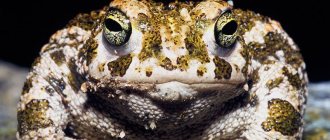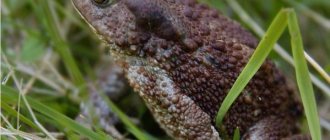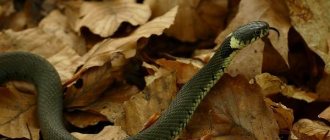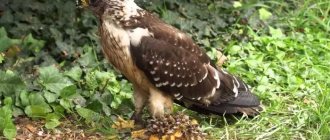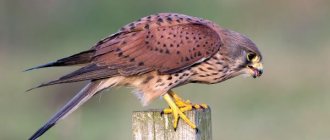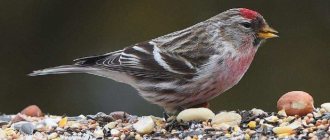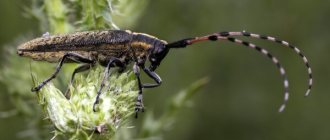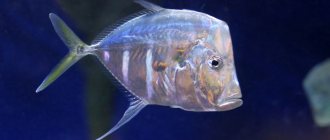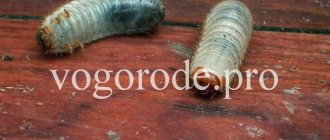- Wild animals
- >>
- Amphibians
Representatives of amphibians do not enjoy favor with people. For many decades, rumors have been spreading about the dangerous and even destructive effects of toads on humans. Many are sure that just one touch to this animal can lead to the formation of a wart, and sometimes to death. However, this is just a myth. And the fact is quite encouraging - the earth toad is one of the most useful amphibians on the planet.
Origin of the species and description
Photo: Ground toad
Due to its external features, the earth toad is often compared to a frog. However, these are two different species of amphibians. The toad belongs to the toad family, the order of tailless animals. Today this family has more than five hundred varieties. However, only six species from the genus can be found in Europe.
It is worth familiarizing yourself with these types in more detail:
- Green. It is distinguished by its bright gray-olive color. On the back, with the naked eye you can see dark green spots decorated with black stripes. For their own safety, adult green toads secrete a special liquid. It is toxic and very dangerous for enemies. Such amphibians prefer to move in steps and practically do not jump.
- Ordinary. The largest species in the family. The body of an adult is wide, colored brown, gray or olive. The eyes are very bright - orange.
- Caucasian. Large amphibian. Its length can reach thirteen centimeters. Skin color is usually light brown, dark gray. This toad lives in mountains, forests and caves.
- Far Eastern. A characteristic feature of this species is a wide range of skin colors, small spines and longitudinal stripes on the upper body. The animal lives in flooded meadows and shady forests.
- Reed. The length of the amphibian is approximately eight centimeters. A bright yellow stripe can be clearly seen on the back. Skin color can be gray, olive, sand.
- Mongolian. This toad has a flattened body, a round head, and bulging eyes. Its length usually does not exceed nine centimeters. A distinctive feature is the presence of many warts.
Range, habitats
Ground toads choose damp places to live, but not necessarily near water bodies. They only need water to spawn.
Important! Due to the diversity of species, the habitat of earth toads is almost everywhere. These amphibians are found on all continents. The only exception, for obvious reasons, is Antarctica.
The rest of the time, toads prefer damp cellars, freshly dug, still wet soil, crevices in the mountains, low thickets of grass in floodplains, and rain forests. But! There are species that live in both steppes and arid deserts.
Return to content
Appearance and features
Photo: Amphibious ground toad
Ground toads have several distinctive features. They completely lack teeth in the upper part of the jaw, unique “parotid” glands are located near the ears, and the paws of males are equipped with special tubercles. With the help of these tubercles, males can calmly stay on the body of females during the mating process.
Interesting fact: The parotid glands perform several functions. Firstly, they secrete a special moisturizing secretion, and secondly, they act as a protective weapon. Some individuals use them to produce toxic poison. However, it is dangerous only for the natural enemies of toads. In humans, this poison can cause only a slight burning sensation.
Most members of the family have a slightly flattened body, a large head, and large eyes. The eyes are placed in a horizontal position. The front and hind limbs have toes. They are connected to each other by a special membrane. It helps amphibians navigate through expanses of water.
An important difference between a toad and a frog is the method of movement. Frogs jump and toads walk. This is due to the small size of the hind legs. Small paws make the animal slow and not so jumpy. But nature has endowed them with another useful quality - the ability to move their tongue with lightning speed. With its help, toads can easily catch insects.
The color of the skin of different representatives varies from sandy to dark brown. The skin of the earth toad is dry, slightly keratinized, and strewn with warts. Body length can reach thirty centimeters. But most often, toads have average dimensions - 9-13 centimeters. The weight of the animal usually does not exceed one kilogram.
When are potatoes ready to be pulled? | Home Guides
Posted by Tammie Painter Updated December 15, 2022
If you have a sunny spot in the garden with loose, fertile soil, you can grow your own potatoes (Solanum tuberosum). Seed potatoes can be purchased from your local potato patch or purchased at garden centers. Within two weeks of the last average frost date in your area, get your seed potatoes in the ground. As the plants grow, mound soil around the foliage to support the plant and encourage tuber formation. If you keep the soil moist and hilly, your potatoes will grow well. To get the maximum yield and the most flavorful potatoes, you need to harvest them at the right time.
New potatoes
Ripe potatoes
Mature potatoes are harvested in the fall or early winter, depending on your plants and the weather. Wait until all of the plant's foliage is dry and withered before harvesting mature potatoes. After the foliage has died, dig up potatoes from one or two plants and rub the skin of the potatoes with your fingers. The skins of potatoes that are ready to be harvested are not easily wiped off. If the skin of the test potatoes still comes off easily, wait a few more days and try a couple more potatoes.
Harvesting Rules
Once your potato foliage has died, remove it from the potato bed as soon as possible. Potato foliage can carry diseases that are transferred to the tubers through contact with the leaves. Additionally, harvest potatoes within a few days during dry weather to reduce the chance of leaf disease spreading. Dig up the potatoes and handle them carefully so as not to damage the skin or damage the tuber. If the skin is truly damaged, set these potatoes aside and eat them within a few days of harvest.
Where does the earth toad live?
Photo: Ground toad in the garden
Representatives of this type of amphibian are widespread. They inhabit almost the entire globe. The only exception is Antarctica. Relatively recently, toads did not live in Australia. However, scientists created a population of poisonous toad there.
Ground toads have become widespread throughout Europe. Various representatives of the family live in Great Britain, the Baltic states, Ukraine, Belarus, and Sweden. Such animals are found in large numbers in almost all regions of Russia.
Interesting fact: The largest ground toads live in Colombia and Ecuador. Their length reaches twenty-five centimeters. However, there are very few such animals left. Today they are on the verge of extinction.
Typically, amphibians choose geographic areas with a similar climate for their residence. This unspoken law does not apply to representatives of the toad family. Such amphibians live in different regions. They live in deserts, swamps, steppes and meadows. Ground toads spend most of their time on the ground. In water they only spawn. Toads tolerate heat, cold, and any other weather conditions well. The only exceptions are very low temperatures, so they cannot be found in Antarctica.
An amphibian with a bad reputation
Dislike for toads goes down through generations. Even in the Middle Ages, these animals were treated with special contempt and fear. In all civilized countries it was believed that touching a toad meant certain death. Moreover, the cause of death was allegedly the poison secreted by the toad through the skin.
Also, its insidiousness and danger for our ancestors lay in the fact that a person could become a kind of incubator for them. They explained it this way: you can drink toad eggs with bad or untreated water, and once in the stomach they will hatch safely and begin active life. For a modern person this sounds crazy, but previously such a condition was treated very actively.
Science has proven that the toad poses no danger to humans. Yes, in the event of an extreme situation for itself, the earth toad can release a special protective secretion from its skin, but it rather serves a deterrent role and will not cause any harm.
What does the ground toad eat?
Photo: Ground toad
The slowness and clumsiness of earth toads is misleading. Many people consider them to be poor earners. However, it is not. These amphibians are excellent hunters! Two factors help them in getting food: the ability to quickly throw out their tongue and natural gluttony. A toad, without moving from its place, can easily grab an insect flying by and have a snack. Frogs don't know how to hunt like that.
Their main diet includes:
- various butterflies;
- snails;
- earthworms;
- insects, their offspring - larvae;
- fish fry.
Large adults also feed on small rodents, frogs and lizards. However, catching and eating such prey is not easy. Members of the family usually go hunting in the evening. They can hunt all night long, waiting in ambush for prey.
Interesting fact: Ground toads provide significant benefits to humans. They can safely be called crop orderlies. In one day, an adult helps get rid of eight grams of insects. This significantly reduces the percentage of crop spoilage.
Toads search for food only in the warm season, alone. Amphibians gather in groups only during the breeding season. In winter they hibernate. To do this, the animal finds the most suitable place for itself. Most often, this place turns out to be abandoned rodent burrows and tree roots.
The benefits of lizards, frogs, toads and hedgehogs on the site
Our dacha is located on the very bank of the Oka River. The coastal zone is planted with various trees and shrubs, so we have a lot of birds, insects and other living creatures at our dacha)). They fly in, crawl, and come running. Some to eat, some to lie down, some to just.
I was looking through photos from last year and wanted to write this post. Probably everyone who has dachas, and even their own houses, can observe such a picture. They bring a dog or a cat, the summer season ends, the owners leave and their poor fellows are left alone.
It would seem that it’s time to get used to it... It would seem, well, what’s special here. And I, along with Alenka, am still delighted with every animal we meet :)) And I always want to share this delight (also childish, probably :)) with friends.
For as long as I can remember, all sorts of animals have always wandered into our country house - kittens, adult cats, and once a dachshund came. A long time ago, when there was no fence yet, a ram was once discovered in the garden, although not very large, but not a lamb either.
See all materials about animals: See all
- Author: Maria Sukhorukikh
Rate this article:
- 5
- 4
- 3
- 2
- 1
(0 votes, average: 0 out of 5)
Share with your friends!
Features of character and lifestyle
Photo: Ground toad in nature
The character of earth toads is quite calm. They spend the day basking in the sun, and in the evening they begin to search for food for food. The heavy body and short legs make these amphibians slow. They move little, and it is very rare to see a toad jumping.
Representatives of the family scare off their opponents with their large body dimensions. If danger arises, the toad arches its back. This technique makes it even visually larger. If the trick does not help scare off the opponent, then the amphibian can make a large single jump.
Video: Earth Toad
Ground toads spend their day not only near bodies of water. They have slightly keratinized skin, so they do not need to be constantly near water. The parotid glands secrete the necessary level of moisture for the skin. This is quite enough. During the day, the animal can safely be in the forest, field, or gardens. Toads move closer to water during the mating season.
During the period of searching for partners and breeding, these animals make a special sound. It often resembles a quack. At other times they are rarely heard. Only when frightened can an amphibian emit a piercing squeak. The entire period of activity of ground toads occurs exclusively in the warm season. When cold weather sets in, animals go into suspended animation.
Getting rid of frogs
Before you start fighting amphibians, you need to understand whether they cause harm. Often, an invasion of frogs provokes the appearance of insects and slugs in basements. From frogs you will receive the help of natural enemies in destroying these pests. It is worth considering various methods for breeding frogs if there are no such pests or the spread of amphibians is widespread.
Before choosing ways to get rid of toads or frogs, you need to eliminate the root cause of their appearance. Often after this they leave the cellar themselves. It is better to take these measures in the spring: then you will not need to make additional efforts. There is a high probability that the frogs will disappear over the summer. It is important to assess the number of amphibians and the potential damage they can cause, and choose: get rid of the toads or leave everything until the fall.
When considering means of control, you need to find a middle ground between their effectiveness and safety. This applies to both chemicals and mechanical devices. Pets and children may be poisoned or injured.
Nets and traps for frogs
This method does not require killing amphibians, but allows you to significantly reduce their number or get rid of them completely.
The nets have proven themselves well in open space conditions. Traps are useful in cases where it is impossible to remove the contents of the basement. They are installed in open space. A prerequisite is the presence of bait.
You can make nets and traps with your own hands from available materials or use a regular net. A fishing or children's one for butterflies is perfect. To collect caught frogs, you will need a tall container with a narrow neck or a closing lid. This way the pests will not jump back out.
Mousetraps are suitable as traps. An excellent bait would be food waste or special granules that are used for mice and rats.
Good homemade traps for fighting frogs in the basement can be made from a fishing net. It is enough to pull it diagonally from the floor to the ceiling. Attach a light bulb on the side opposite to the cluster of toads. It will attract insects, which will become a natural bait for amphibians. Instead of a grid, a tall barrel with a light source located above it is suitable. The frogs will jump after the mosquitoes and end up in a container from which they will not be able to escape.
Chemicals
The method involves the use of potent poisons. Such drastic measures to remove amphibians from the cellar are best left for last. If there are animals or children, you will have to additionally fence the cellar, since chemicals getting on the skin or in the digestive system can lead to burns or poisoning.
Before purchasing, you need to carefully read the instructions for the anti-frog product and pay attention to the following nuances:
- degree of danger to others;
- the need to remove the contents of the cellar;
- time of action;
- mode of application;
- residual effect.
Chemicals are more often used if other measures do not help get rid of frogs. In this case, you need to give preference to powerful drugs. They will require the removal of all contents from the cellar. Be sure to check the expiration date of the composition and after it has expired, ventilate the room well. The poison should be spread in areas where amphibians are most likely to move: at the entrances to the basement, near burrows, cracks in walls and floors.
If there are no special means to combat frogs, the use of universal insecticides and compounds against snakes is allowed.
Folk methods of struggle
Before starting to use poisons, many people think about how to remove frogs using safe means. Often the effect is no worse. Thanks to this, the toad will not die, but will simply get scared and run away. Well proven in practice:
- Lemon acid. You need to prepare a strong solution: 400 g of powder per 4 liters of water. All horizontal surfaces are sprayed with it. It irritates the skin, causes burns, and in high concentrations kills frogs.
- Salt. It is enough to scatter it on the floor. Frogs will get burned if they come into contact with the crystals. The remedy is rarely fatal, but it forces frogs to change their habitat. In addition, salt absorbs moisture well. This will help dry the room further.
- Very strong coffee. It works in a similar way. The surfaces are sprayed with the decoction. The use of coffee grounds is allowed; they are laid out at entrances and cracks.
The main advantage of folk remedies is safety for vegetables and preparations. It is better to remove the contents of the basement, but if this is not possible, the listed compositions will become the only means of combating amphibians.
Social structure and reproduction
Photo: Ground toad
The mating season for earth toads begins with the first warmth - in the spring. In the tropics, this period falls during the heavy rainy season. During the mating season, these amphibians gather in groups and only near reservoirs, rivers, and swamps. Water is of strategic importance for reproduction. Only in water can toads spawn. At ponds, males appear first, then females. The females enter the water and begin to spawn. The males climb onto their backs and fertilize these eggs. After fertilization, the toads leave the pond.
In water, future offspring turn from eggs into small tadpoles. They will live in water for about two months. At this time, tadpoles feed exclusively on algae and small plants. After this, the tadpoles turn into full-fledged toads. Only then can they go ashore. The rate of development of eggs depends on several factors: the type of toad, ambient temperature, and water. Typically this period lasts from five to sixty days.
Some species of toads do not leave the eggs after fertilization. They carry it on their back until the larvae emerge. There are also viviparous individuals. However, there are very few of them left and they live only in Africa. At one time, such an amphibian can give birth to no more than twenty-five babies.
Interesting fact: There are many species of ground toads in which the male plays the role of nanny. He wraps the ribbons around his paws and waits for offspring to emerge from them.
Interesting Facts
- In some species, the male is most involved in the birth of offspring. It sits in an earthen hole with ribbons of caviar wrapped around its paw until the tadpoles begin to hatch.
- There is a myth that a toad can “give” a person warts. And this is absolutely untrue. All amphibians, with the exception of the aga, are completely safe for humans .
- In some countries, ground toads are specially bred to combat mosquitoes, slugs, flies and other insects.
Natural enemies of earth toads
Photo: Ground toad in Russia
The ground toad is defenseless against many other animals and humans. Enemies surround her on all sides. Storks, herons, and ibises hunt her from the sky. They deftly grab amphibians on the fly. On land they are in danger from foxes, minks, wild boars, otters, and raccoons. And the worst enemies are snakes. There is no escape from them.
The toads' only defense against enemies is the toxic liquid on their skin. However, not all members of the family can produce it. Other toads only have to skillfully camouflage themselves in the greenery. This defenseless animal is saved from extinction only due to its high fertility.
Also, many adult individuals and tadpoles die at the hands of humans. Some kill them for their own amusement, others try to domesticate them. It is possible to keep such amphibians at home, but not everyone succeeds. Improper maintenance often leads to death.
Do frogs eat slugs? Who eats slugs or nature to help us.
I have never heard or seen anything about slugs in my garden. And then suddenly they appeared in such numbers, as if a dam had broken. I realized that my chickens, who always walked freely around the beds after harvesting, ate not only adult mollusks, but their eggs too. An eaten garden parasite is not capable of laying eggs. The transition to natural farming made it possible for both earthworms and woodlice to live, but why are slugs worse? This year my broilers ruined the topsoil in the beds. At the same time, they devoured all the slugs. This is not good, because slugs can carry parasites that are dangerous for chickens.
Moreover, laying hens should not be allowed to peck at them, because the hens will sharply reduce the supply of eggs by lunchtime.
Hedgehogs, moles, starlings, jackdaws and rooks eat slugs, but frogs do not refuse them. Here there is material for thought: who is better for the garden, a mole who will eat a slug and destroy all the plants, or a hedgehog who himself is not averse to eating our green vegetables?
Lizards, salamanders and snakes disappear immediately. There are ground beetles, toads and frogs left - they need to be taken as helpers and companions, conditions for reproduction and life must be created.
Why slugs are useful can be read in the article “Soil animals or why you shouldn’t dig the soil.” There is no benefit from the whitefly; the meadow moth only brings harm.
Tell your gardener friends and gardeners about ways to protect vegetable crops from the pest that eats everything in their summer cottages.
Population and species status
Photo: Ground toad on a stone
The ground toad is a widespread animal. Their population as a whole is not of concern. These animals are quite fertile, so they quickly renew their numbers. However, certain species of ground toads are in great danger - on the verge of extinction. These include the reed toad, viviparous toad and Kihansi.
